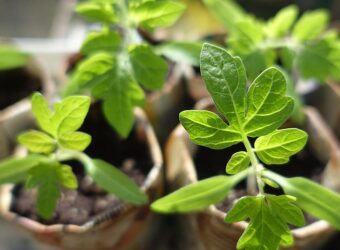Every plant expert tells you to mulch your plants. There are so many mulches out there; how do you choose? This guide will tell you all about choosing and using mulch.
What Is Mulch?
Mulches are used to cover the exposed soil in landscape beds and vegetable gardens and around trees and shrubs.
Advantages and Disadvantages of Mulch
Mulches are used to cover landscape beds and vegetable gardens and around trees and shrubs. Mulches, when properly used, have the following benefits.
- Reduce soil erosion and compaction
- Moderate soil temperatures so the soil is warmer in winter and cooler in summer.
- Moderate soil moisture so your expensive water does not evaporate as much.
- Keep weeds from growing
- Add an inch of organic matter to your soil yearly
- Keep soil from splashing on plants, fruit, and flowers to reduce diseases
- Protect vegetables and fruits from the soil
The only disadvantages to mulch are the cost and the time and effort to apply mulch to your landscape. Most mulch is made from byproducts of the lumber industry or from reclaimed materials.
Living Versus Organic Versus Synthetic Versus Inorganic Mulch
Mulches come in four categories: living, organic, inorganic, and synthetic.
Living Mulch
Living mulches are ground covers or cover crops planted to slow erosion, protect the soil, and look nice. They can compete with your plants for sunlight, space, water, and nutrients, so if those are limited, choose another mulch.
Synthetic Mulch
Any mulch created out of materials people make is a synthetic mulch. Recycled tires are often turned into rubber mulch or chips. The advantage of these mulches is that they last a long time. The problem is that when they do break down, they may release toxic chemicals into the soil.
Organic Mulch
Organic mulches were once alive but are not now. They include pine bark, pine straw, straw, hardwood bark, and sawdust. They decompose over the course of the year, so have to be topped off each year to maintain the proper thickness of mulch. Sawdust and fine wood chips can tie up nitrogen when decomposing, so extra nitrogen has to be used to fertilize your plants.
Inorganic Mulch
Inorganic mulches are stones, concrete pavers, tumbled glass, gravel, and similar materials. They also last a long time. However, they can block water from absorbing into the soil and cause flood issues. As time passes, organic matter like leaves can accumulate on these mulches and serve as spaces for weeds to grow. These mulches have to be maintained by blowing them clean seasonally or more frequently to keep them clean.
What I Consider When Choosing Mulch?
There are so many types of mulch it can be confusing to find the right mulch for your landscape. Here are the things I consider when buying mulch.
Use
The first question I ask is the use for the mulch. Are you trying to control weeds around a tree or shrub? Or a vegetable garden? What about building a path through a garden? Or cushioning a play area for children?
I use coarse mulch for paths but buy finer mulch to place around my vegetable garden to deter weeds. I would never use synthetic mulch around food plants but might use it in a play area so children falling don’t hurt themselves. Some mulches can acidify the soil, like pine straw and pine bark. If I need alkaline soil, I pick hardwood mulches instead.
Cost
I consider the price of the mulch and how much I need it for my application.
Obviously, inorganic mulches are more expensive than organic mulches. However, one brand of hardwood mulch is much like another, so I would pick one price there.
Some mulches are only available regionally. For instance, we don’t use straw where I live because we don’t raise grain crops much here, but in other areas, it is the cheapest mulch available.
Appearance
Mulch should look nice when used around trees, shrubs, and in landscape beds. Some mulch is even available in different colors if you don’t mind the dyes they use. Red or black mulch might set off your plants more than the natural brown color.
The 23 Different Types of Mulch
Here is a list of all the kinds of mulch I could find, along with its uses, general cost, and pros and cons.
1. Ground Covers
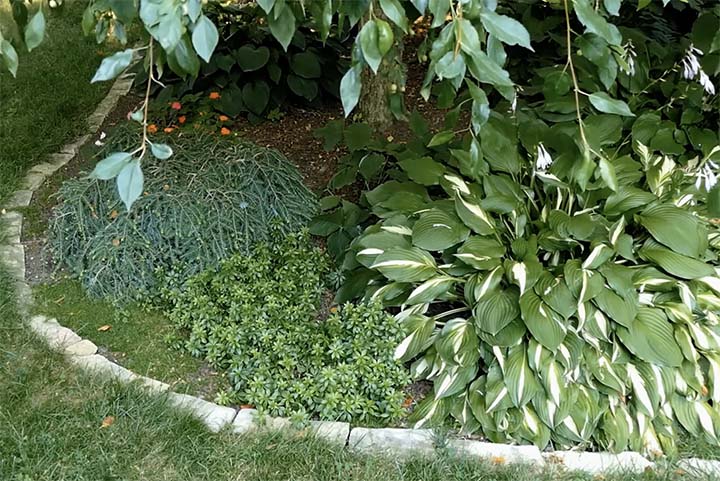
Type: Living
Price Range: $0-100, depending on plant chosen and amount needed.
Durability: If using native and adapted plants, very good.
If you have a shady area around a big tree and don’t want to cover the ground under it with static mulch, you can plant a ground cover under the tree.
Ground covers such as creeping thyme will grow in the dappled shade of the tree and cover the bare ground. They look nice and protect the roots of the tree as well as the soil.
Ground covers are sometimes used between rows of a vegetable garden or on the ground of a fruit orchard. They repel weeds and keep the soil cooler in the summer and warmer in winter than bare soil.
Living mulches also help absorb water and hold the moisture longer than bare soil.
The disadvantages of ground covers are that they take away water, space, and nutrients that your primary plants may need. This is more of a problem in a vegetable garden than under a tree.
Living mulches also have to be trimmed back when they leave the area you want them in, such as growing onto the lawn or landscape beds.
During the winter, the ground cover may die back and not cover the ground.
Pros:
- Looks nice
- Easy to care for
Cons:
- Can compete with primary plants
- Can overgrow the ground they are supposed to cover and invade lawns and flower beds.
2. Cover Crops
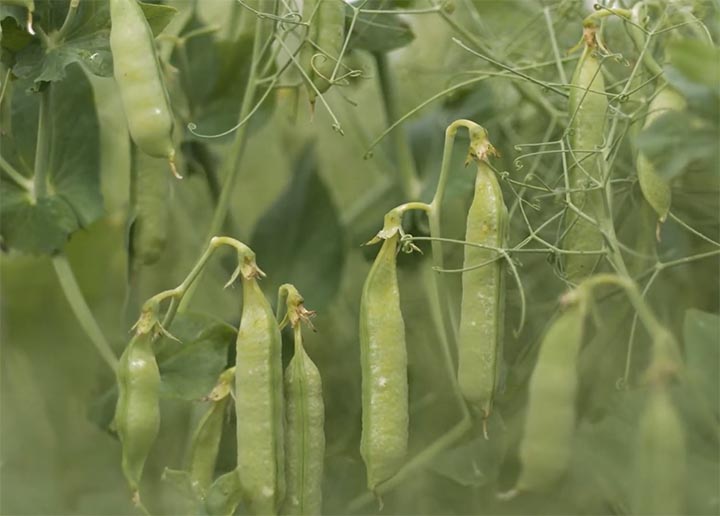
Type: Living
Price Range: $0-$100, depending on what you choose and how much ground you need to cover
Durability: Lasts a season
Cover crops are usually planted in vegetable gardens and orchards.
In vegetable gardens, they protect the soil from erosion, keep out weeds, and return nutrients to the soil. In orchards, they do that but also stabilize the soil temperature and moisture.
Usually, a legume is chosen that fixes nitrogen and adds it to the soil. When the season is finished, the cover crop is typically tilled under to add organic matter to the soil and additional nutrients which the next crop can use.
For example, I might plant vetch in the late fall after everything is harvested from my vegetable garden. In the spring, I till the vetch under and plant my onions and other vegetables.
The risk with cover crops is that they can become weeds if you do not till them under well. They can also escape the area you want them in and become a problem in lawns and landscape beds.
Cover crops need to be watered while they become established and in periods of drought.
Pros:
- Protects the soil from erosion
- Keeps weeds out
- Adds Nitrogen to the soil
- Adds organic matter to the soil
Cons:
- Can become a weed in lawn and landscape beds
- Must be tilled under well or will become a problem for subsequent crops
- Must be watered
3. Recycled Rubber Shreds and Chips
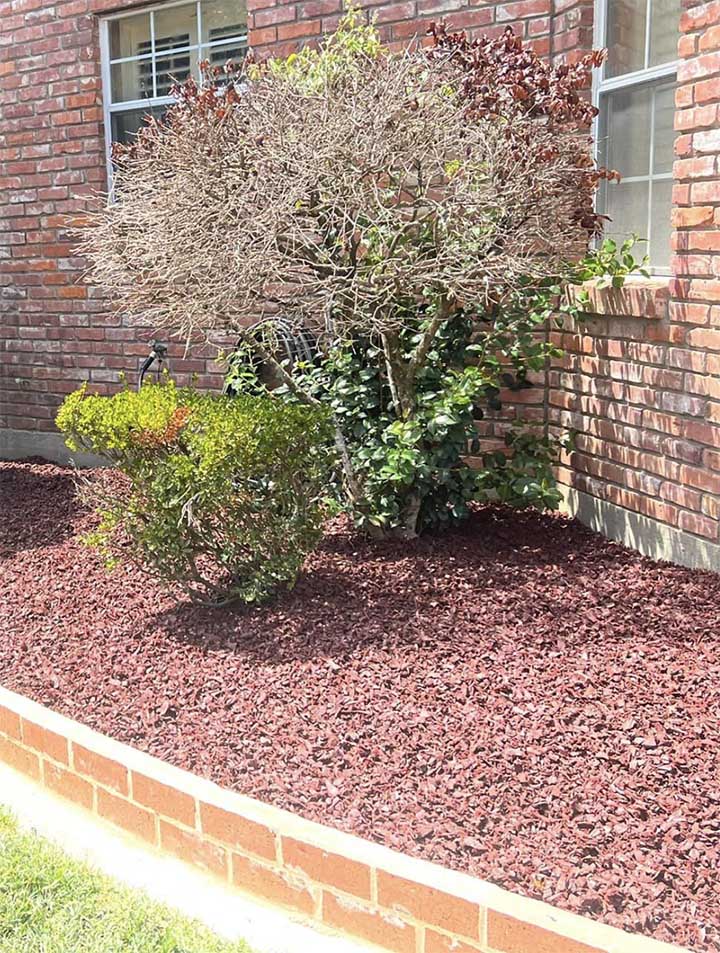
Type: Synthetic
Price Range: $50-$60 a 1.5 cubic foot bag
Durability: Long lasting
Recycled rubber shreds and chips have been used as a mulch in high-traffic areas, in playgrounds, and other places where a long-lasting, durable product is needed.
In addition, it is heavy enough not to blow away. It was used in playgrounds because it has a cushiony effect if a child falls to the ground. It will keep weeds from growing in the area.
This mulch has fallen out of favor in the last few years. It is expensive to put down the two to four inches of mulch you need to keep weeds at bay. Organic matter, such as leaves, can accumulate on it, and weeds can grow on that, so the mulch has to be blown clean at least seasonally.
Removing the mulch to use the ground for another task is difficult.
Finally, while it takes this mulch a long time to break down when it does break down, it can release harmful chemicals and heavy metals into the area.
Pros:
- Durable
- Won’t blow away
- Takes traffic well
- Keeps weeds from growing
- Keeps soil from eroding
Cons:
- Expensive
- Difficult to remove
- Must be blown clean seasonally
- Leaches heavy metals and toxic chemicals when it breaks down
4. Stones and Pebbles
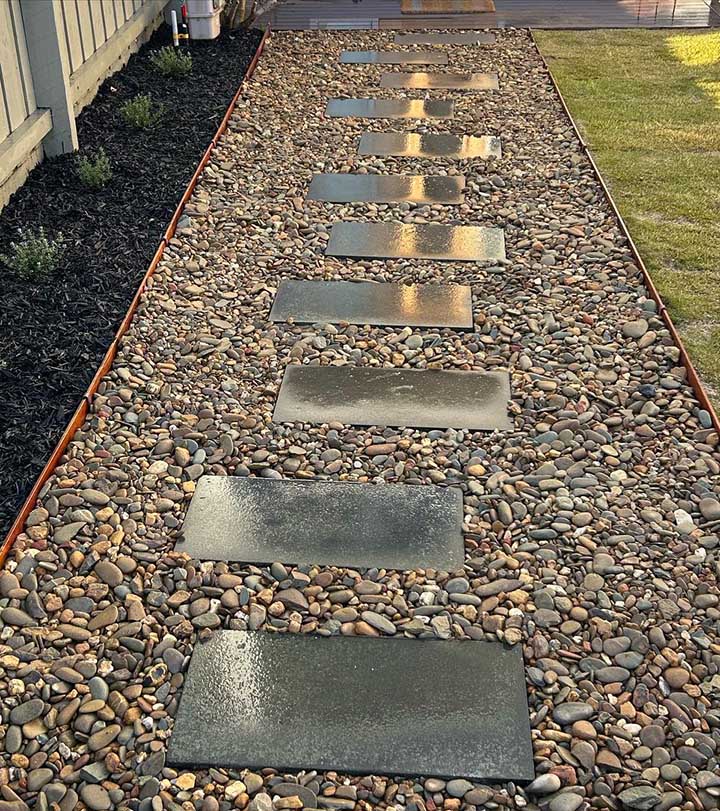
Type: Inorganic
Price Range: $15-$40 for .4 cubic feet of gravel
Durability: very durable
Using small stones and pebbles as a mulch on walkways and parking areas is very common. It is not used very much in actual growing areas, such as a garden.
Stones and pebbles can take heavy traffic and can keep people from walking in mud when it rains. They are durable and long-lasting. Inexpensive.
Stones and pebbles have to have a base layer to work well, which requires work to lay down. They have to be maintained by blowing off organic matter and adding amounts of stones or pebbles as they are picked up in shoes and disappear.
They are also vulnerable to being pounded into the ground and losing their effectiveness as a mulch. Stones and pebbles can affect how water is absorbed into the ground, so rainwater may have to be managed.
They are hard to remove if you decide to repurpose the land. Stones and pebbles may be removed from rivers and creeks in a way that is not environmentally sustainable.
They should not be used around acid-loving plants because they may leach alkaline material in the rain. Stones and pebbles heat up in the summer and can burn bare feet.
Pros:
- Durable
- Takes traffic well
- Long-lasting
- Can look attractive
- Permanent
Cons:
- Expensive
- Must be blown seasonally to remove organic matter
- Must be topped off periodically
- May affect rainwater absorption
- Difficult to remove
- Gets hot in summer
5. Crushed Lava

Type: Inorganic
Price Range: $13-$20 for .2 cubic feet of small lava rock
Durability: very durable
Crushed lava is frequently used for paths and parking areas as an alternative to gravel. It is durable and comes in several colors, making it very decorative. Crushed gravel is inexpensive.
Crushed lava has the same downsides as gravel. It has to be topped off periodically and can accumulate organic matter and weeds. It is hard to remove.
Crushed lava also requires a base level to provide a stable walk. In addition, crushed lava is a limited resource and may not be removed in an environmentally sustainable manner.
Crushed gravel can get hot in the summer and has sharp edges, so people should not walk on it in bare feet.
Pros:
- Permanent
- Inexpensive
- Decorative
Cons:
- Can accumulate organic matter and weeds
- Must be topped off periodically
- May not be environmentally sustainable
- Gets hot in the summer
6. Landscape Plastic
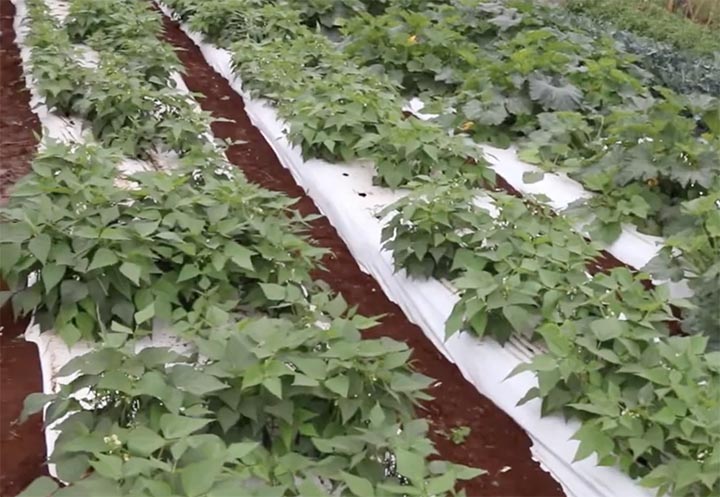
Type: Synthetic
Price Range: $14-$20 for a 10X25 foot roll
Durability: Lasts a season to a year, depending on the plastic and use.
Landscape plastic is often used in gardens to prevent weeds, retard ground-dwelling insects, prevent soil from splashing on plants, and warm the soil in the spring. It can be used as an underlayer and covered with another mulch or be used alone.
Landscape plastic is laid down and held down with stakes or rocks, then holes are cut into which plants are transplanted. It is usually used with drip irrigation for each plant.
Landscape plastic is not attractive and is usually covered with another mulch. It can prevent water from absorbing into the ground. It has to be replaced every season.
The plastic can heat the soil too much in the summer and cook the plant roots if you live in a hot climate. Responsibly discarding large quantities of landscape plastic can be difficult.
Pros:
- Inexpensive
- Keeps weeds from growing
- Can warm soil in the spring
- Can block soil-borne diseases and soil-borne insects from the plant
Cons:
- Must be replaced each season
- Blocks water absorption during a rain
- Can heat the soil too hot in hot climates
7. Landscape Fabric

Type: Synthetic
Price Range: $65-$75 a 100-foot roll
Durability: Durable
Landscape fabric is a woven cloth that is put in landscape beds to block the weeds. It allows air and water to penetrate but blocks sunlight. Holes are cut in it to plant the plants.
It is more durable than plastic and is intended to last much longer. This is one of the reasons why Briana loves to use it for mulching tomato plants on her farm.
Landscape fabric is not attractive and is usually covered with another form of mulch once the plants are planted. It must be held down with mulch or stakes.
Pros:
- Blocks weeds
- Allows air and water to reach soil
Cons:
- Must be anchored with stakes
- Unattractive
8. Concrete Pavers
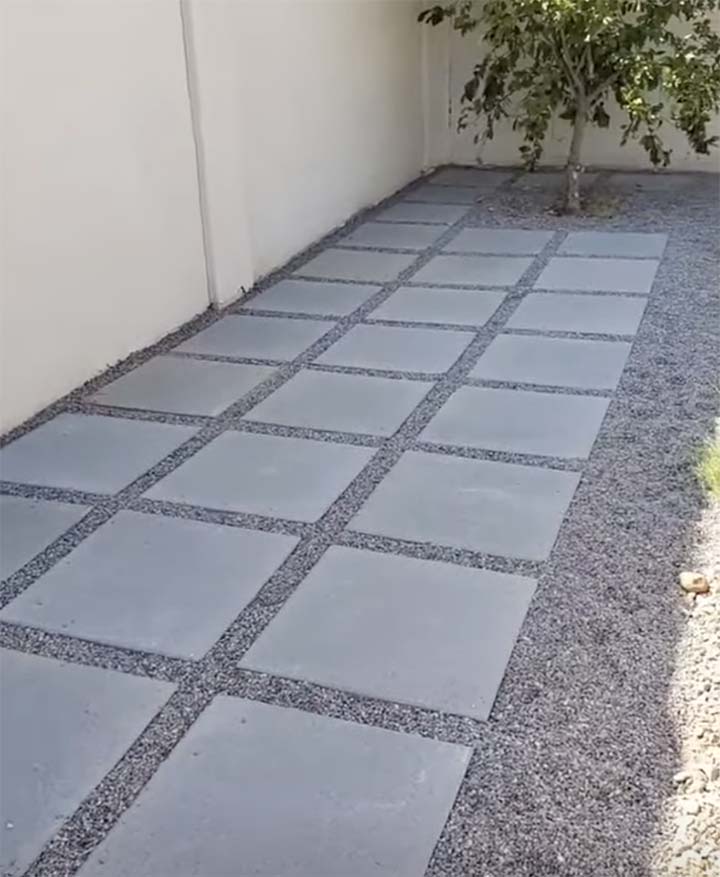
Type: Inorganic
Price Range: $0.50-$7.50 a paver, depending on size and shape
Durability: Very durable
Concrete pavers are used to cover paths, driveways, and patios. They are very durable.
Concrete pavers are inexpensive, and there is a wide selection of sizes and shapes. They can be quite attractive.
Pavers do block water from reaching the soil. Done correctly, concrete pavers require a base layer. Organic matter can accumulate on the pavers and host weed seeds.
Weeds can also grow up between the joints between pavers. Sand can wash out of the joints and destabilize the pavers and will have to be redone periodically.
Pros:
- Permanente
- Inexpensive
- Available in a wide variety of shapes and sizes
Cons:
- Requires a base layer
- Needs periodic maintenance to maintain joints
- Needs seasonal blowing to remove organic matter
- Blocks water from soil so may affect drainage
9. Hardwood Chips and Bark

Type: Organic
Price Range: $3-$6 a three cubic foot bag, a little more if the mulch is dyed.
Durability: Lasts about a year
Hardwood chips are used as mulch around trees, shrubs, ornamental plants, and vegetable plants. A three-inch layer of them will keep weed seeds from reaching the surface and growing.
Hardwood chips allow air and water to reach the soil easily. They help moderate soil temperature, conserve soil moisture, and reduce ground insects.
Each year, about an inch of the mulch decays and becomes organic matter in the soil, so each spring, you should add an inch of mulch to your beds.
This uses a lot of nitrogen, so you may need to add some extra nitrogen when you fertilize your plants.
Hardwood bark is coarser than chips and is usually used for paths through the garden but can be used as a mulch too.
Both hardwood chips and bark are a byproduct of the lumber industry and would otherwise go to waste. You can often get free hardwood chips from municipalities that cut trees and branches away from power lines and chip them. You just have to load them up and haul them off.
Be a little cautious about chips from municipal sources and tree services. If the tree that was chipped is diseased, you may introduce the disease into your landscape. Bagged chips and bark are heat treated to prevent that.
You can also get hardwood mulch that is dyed in different colors. Hardwood chips do not acidify the soil like pine bark and straw.
Do not use hardwood chips or bark against the house as it can pose a termite danger.
Pros:
- Cheap and easily available
- Blocks weeds
- Allows air and water to reach the soil
- Moderates soil temperature
- Conserves soil moisture
- Adds organic matter to the soil
- Dyed chips available
Cons:
- May tie up nitrogen in the soil, so more has to be added
- If the tree the chips came from is diseased, can introduce the disease to your landscape
10. Sawdust
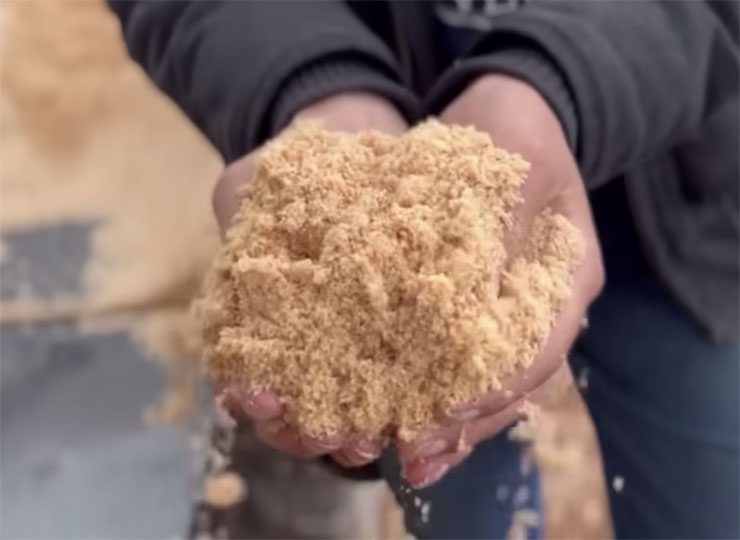
Type: Organic
Price Range: $0-$2 a bag
Durability: One season or less
Sawdust is sometimes used as a mulch. It is not a good mulch, however.
Sawdust is vulnerable to compaction, can be hard for air and water to penetrate, and does a poor job of keeping weeds away.
In addition, it acidifies the soil. I would not recommend using sawdust as a mulch. It is cheap and is available free from many sawmills or cabinet shops.
If you do use sawdust, do not use sawdust from treated lumber near your vegetables because it contains arsenic that leaches into the soil and is picked up by the plants.
In addition, the soil microbes that break sawdust down suck all the nitrogen out of the soil to do so. You will have to add extra nitrogen so your plants have some to use.
Pros:
- Cheap
- Can be used to acidify soil
Cons:
- Doesn’t retard weeds well
- Uses the soil Nitrogen
- Compacts and retards water and air
11. Pine Straw

Type: Organic
Price Range: $0-$45 a bale, depending on the area you live in
Durability: Resists rotting, lasts several years
Pine straw is readily available if you live near a pine forest but can be expensive and hard to find otherwise. It is good for acidifying the soil but may take several years to achieve that.
Pine straw is used to cover the soil in vegetable gardens, around acid-loving plants like blueberries, and around trees and shrubs. The pine straw needs to be three inches deep to retard weeds.
It allows air and water to penetrate the soil. In addition, it stabilizes soil temperature and moisture. Pine straw decomposes very slowly, so add organic matter to the soil before adding the pine straw if your soil needs it.
You should add an inch each spring to any pine straw mulched areas. Pine straw can be a fire hazard, so don’t use it near the house.
Pros:
- Can be readily available in pine forest areas
- Durable
- Allows water and air through to the soil
- Slugs and Snails do not like to go over pine needles
- Retards weeds
- Acidifies soils over time
- Easily removed
Cons:
- Can be difficult to find
- Fire hazard
12. Pine Bark
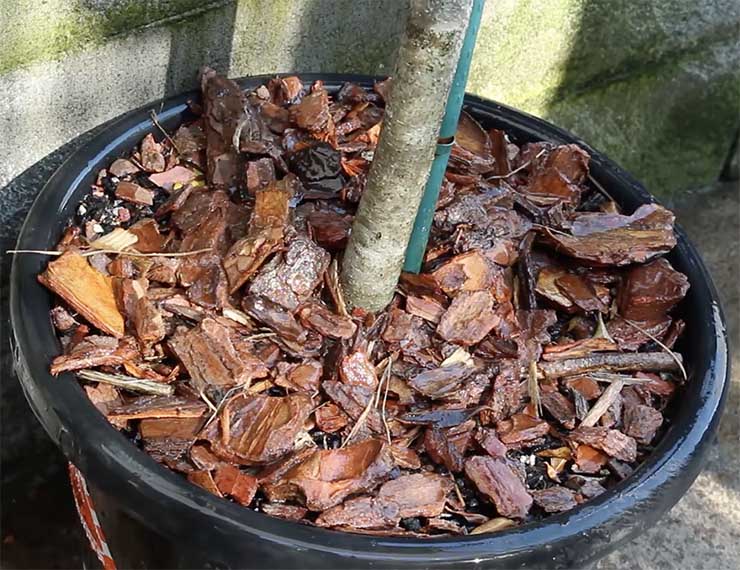
Type: Organic
Price Range: $0-$10 for two cubic feet, maybe cheaper near pine forest
Durability: Resistant to rot, several years
Pine bark is used similarly to hardwood bark. Use it in a three-inch-deep layer around trees, shrubs, ornamental plants, and vegetable plants.
Pine bark will acidify the soil over time, but it takes several years. Using it as a mulch around acid-loving plants such as blueberries is helpful.
Pine bark resists rotting and compaction. It keeps weeds from growing, moderates soil temperature and moisture, and does not blow away. It can be hard to find in a region with few forests.
Do not use pine bark against your house. Leave a six-to-ten-inch buffer to keep termites from using it as a bridge to your house. Add an inch of pine bark to your mulched areas every spring to replace what has decomposed and brighten the beds.
Pros:
- Rot-resistant
- Allows air and water to reach the soil
- Can acidify the soil over time
- Resists compaction
- Doesn’t blow away
Cons:
- Can be used as a bridge for termites to your house
- Fire hazard
13. Straw

Type: Organic
Price Range: $0-$20 depending on where you live
Durability: Not durable at all; short-term mulch
Straw is left behind after wheat and other grains are harvested. It is generally clean and does not have weed seeds in it. In grain-growing areas, it is readily available. In other areas, it may be hard to find and expensive.
Straw is frequently used in a vegetable garden or around strawberries because it lasts just about as long as it takes to harvest the vegetables and berries.
It is also used to establish turf grass because it decomposes about the time the turf grass gets established.
In cold areas, it is used as a winter mulch to protect tender crowns and bulbs. It doesn’t mat and is less likely to smother the plants.
When the straw decomposes, it can tie up the nitrogen in the soil. Add nitrogen to the vegetable garden when using this mulch. Straw does allow air and water to reach the soil. In addition, as it decomposes, it adds organic matter to the soil.
Straw can blow away, and dry straw can be a fire hazard. Mice and other rodents may winter in the straw in cold areas, so don’t use it against trees and shrubs.
Pros:
- Good insulator to protect tender plants over the winter
- Doesn’t mat or smother plants
- Adds organic matter to the soil as it decomposes
Cons:
- Can blow away
- Fire hazard
- Mice and other rodents may winter in it
- Decomposes quickly
14. Hay
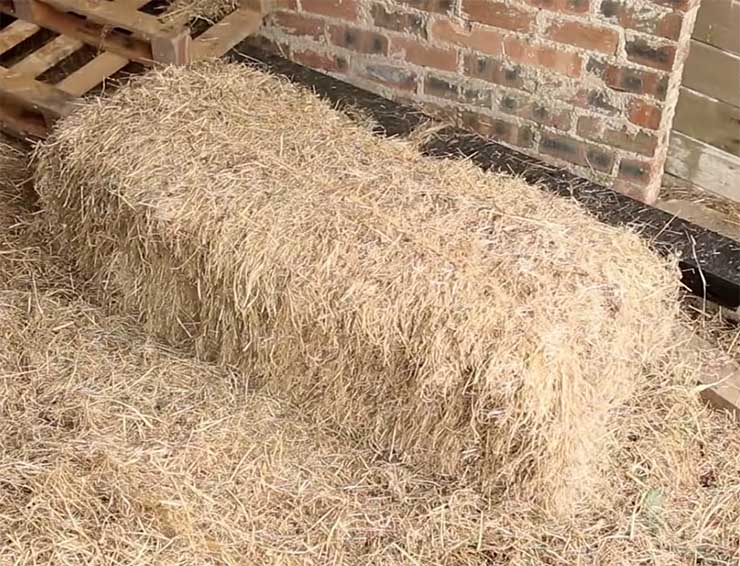
Type: Organic
Price Range: $5-$10 a bale
Durability: Very poor
Hay is a readily available commodity that can be used as a mulch. It is very similar to straw but with one important difference.
Hay is cut from a meadow and often includes weed seeds. If you use the hay as a mulch, the weed seeds germinate and cause problems.
While hay will allow water and air to reach the soil, it is a poor choice next to straw. It will blow away and can be a fire hazard, just like straw.
I recommend you use straw instead of hay to avoid spreading weed seeds into your garden and landscape beds.
Pros:
- Good insulator
- Adds organic matter to the soil as it decomposes
Cons:
- Spreads weed seeds all over the garden
- Can blow away
- Fire hazard
15. Crushed Nut Shells
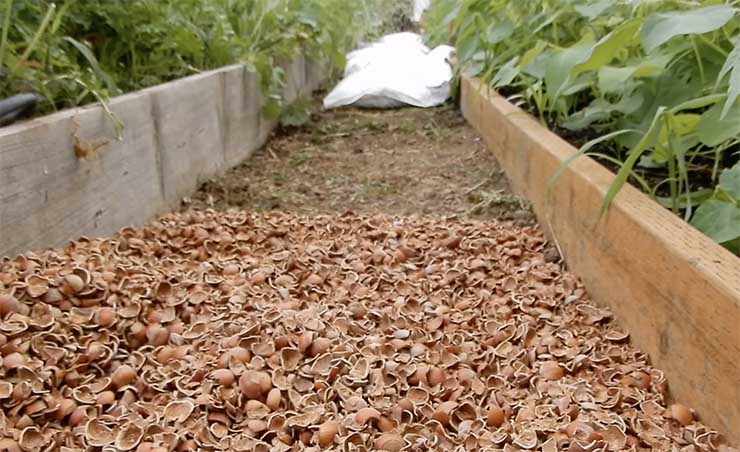
Type: Organic
Price Range: $0-$20 a bag, depending on where you live
Durability: Lasts several seasons
Crushed tree nut shells are effective at maintaining soil moisture and temperature. They are available regionally. Hazelnut shells in the northwest, pecan shells in the south, etc., are available.
They last several seasons if they are crushed. Ground shells are like sawdust and compact, shed water, and rob nitrogen from the soil, so used crushed ones.
You may be able to get the shells for free from a nut processing plant or orchard. If you don’t live in an area with commercial nut orchards, you probably won’t be able to find crushed nut shells at a price that makes sense.
Pros:
- Durable
- Maintain soil moisture and temperature
Cons:
- Limited availability
16. Compost
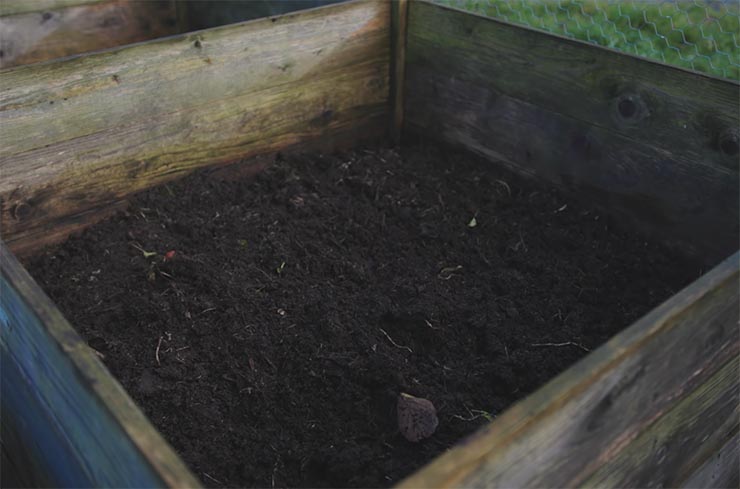
Type: Organic
Price Range: $0-$10 a bag
Durability: Decomposes rapidly, doesn’t last more than a season
Compost is not something I think of as a mulch, but I do spread it on my vegetable garden. Where I live, we recommend people spread three inches of compost over their soil and till it into a depth of six inches.
Compost can be spread on the surface of the soil, too. It feeds the soil microbes, improves soil structure, and improves the soil’s ability to absorb water.
You can make your own compost or buy it at most big box stores and nurseries. If you buy bags of compost, make sure it is finished before putting it on your plants, or it will burn them.
You can even get it delivered in bulk in most places. Compost is a slow-release source of nitrogen. It really has no cons.
Pros:
- Improves soil structure
- Improves soil’s ability to hold moisture
- Adds nitrogen to the soil
Cons:
- None
17. Newspaper

Type: Synthetic
Price Range: free to $2.00 per newspaper
Durability: Decomposes very quickly
Newspaper is great to use when establishing a new raised bed and in vegetable gardens. Eight sheets of newspaper put in the bottom of a raised bed will choke out the grass and other plants under them. Fill the raised bed with soil/compost without having the grass invade it from the bottom.
Newspaper lets in water and air and decomposes very quickly. Many newspapers use soy-based ink, so there are no harsh chemicals in a newspaper.
Newspaper can be used in a vegetable garden between rows and around the plants to stop weeds from growing. As the newspaper decays, it adds organic matter to the soil.
Newspaper is light and must be held down, or it will blow away. It doesn’t look very good and is usually covered with soil or another mulch.
Pros:
- Blocks weeds
- Allows water and air to reach the soil
- Readily available
- Inexpensive
Cons:
- Decomposes quickly
- Needs something to hold it down
- Unattractive
18. Cardboard

Type: Synthetic
Price Range: $0-$5
Durability: Decomposes in a season
Cardboard is often used to cover an expanse of grass in order to establish a raised bed or new flower bed. The thick cardboard blocks the sunlight from the plants under it and kills them.
Cardboard allows water through it and decomposes after the plants under it are dead. It is readily available as a waste produce from stores.
Cardboard also does well as a mulch in a vegetable garden between rows. New landscape beds can benefit from a layer of cardboard to choke out any pre-existing plants.
Avoid using waxed cardboard because it is waterproof. Make sure the cardboard overlaps and water it to stick the cardboard to other pieces of cardboard and the soil.
You will have to put something on the cardboard, like mulch or soil, to keep it from blowing away. It doesn’t look very good anyway, so is usually covered.
Pros:
- Chokes weeds growing below it
- Readily available
- Inexpensive
- Decomposes in a season
- Allows water and air to reach soil
Cons:
- Can blow away
- Unattractive
19. Cottonseed, Buckwheat Shells, Cocoa Shells

Type: Organic
Price Range: $20-$30 a bag, depending on region, may get free from gins
Durability: Lasts a year or more
In different parts of the country, you can get cottonseeds, buckwheat shells, and cocoa shells. These are byproducts of other industries.
They are durable and may be decorative. They make nice mulch for ornamental landscape beds. Do not use them around vegetables or other food plants.
Cottonseeds should be from an organic cotton farm. Conventional cotton is sprayed with compounds containing arsenic and can poison your soil.
Cocoa shells are a byproduct of the chocolate industry. They are toxic to dogs. In addition, they are high in phosphorus, so should not be used if your soil already contains lots of phosphorus.
While these products may be cheap and look decorative, you would do better using bark or chips from trees. You do not have to worry about what they have been sprayed with before using them.
Pros:
- Durable
- Inexpensive
- Allows water and air to reach soil
- Keeps weeds from growing
Cons:
- Toxic to dogs
- Possible arsenic contamination
- Limited availability
20. Grass Clippings
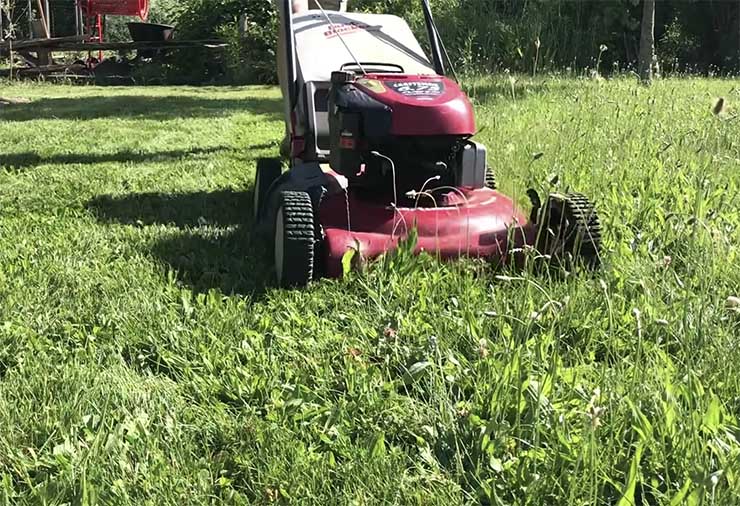
Type: Organic
Price Range: Free
Durability: Very poor
Grass clippings can be used as a short-term mulch in gardens and around new plantings. However, they decompose quickly, so won’t work for long.
Grass clippings may contain weed seeds that will germinate and cause a problem in your garden.
Never use grass clippings from a lawn that has been treated with a herbicide, or you may kill the plants you are trying to protect.
A large amount of grass clippings being used at once can use the nitrogen in the soil as they decompose. Add extra nitrogen in that case.
Grass clippings are better used in a compost pile than as a mulch.
Pros:
- Free
Cons:
- Can contain weed seeds
- If treated with herbicide, clippings can kill plants
- Decompose quickly
21. Leaves
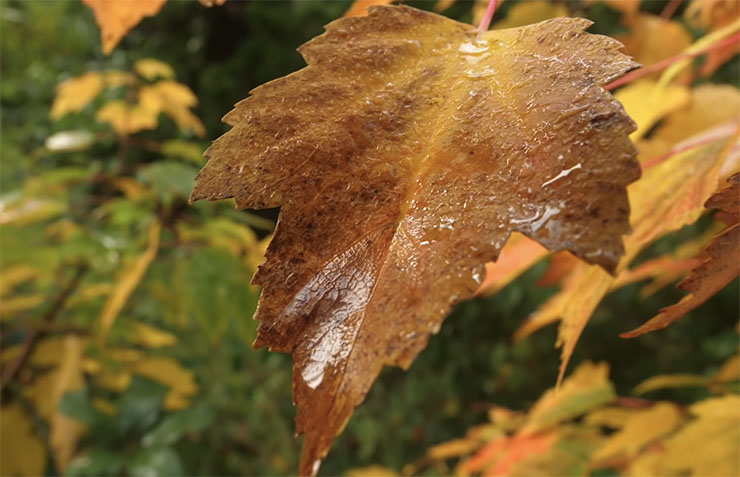
Type: Organic
Price Range: Free
Durability: Very poor
Leaves make a good temporary mulch. They decompose quickly and can form mats. Shredding them makes them decompose more quickly.
Using leaves to cover tender plants and bulbs for the winter is a good use of them. They decompose about the time the plants start to grow for the year.
I compost my leaves and then spread the compost to fertilize my garden. Leaves will blow away unless wet or covered with another mulch.
Pros:
- Free
- Good insulator
Cons:
- Decompose quickly
- Will blow away
22. Cypress Bark
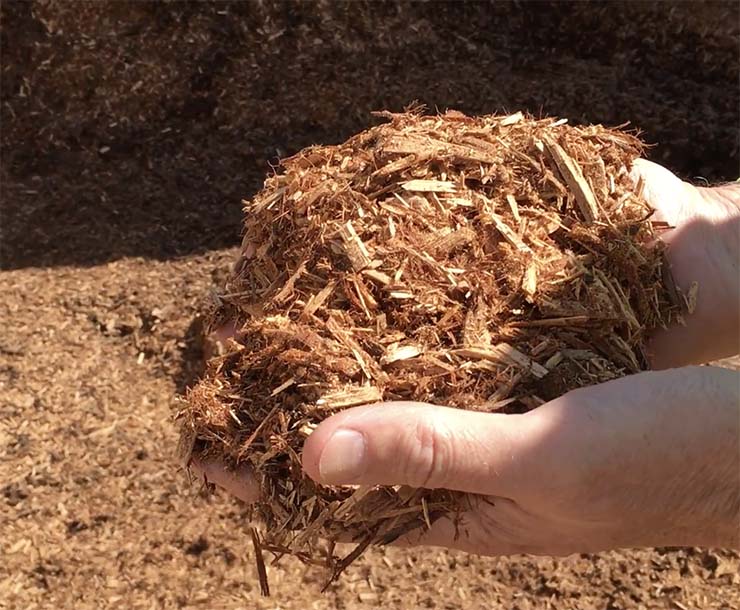
Type: Organic
Price Range: $5-$10 a bag
Durability: Good durability, lasts several years
Cypress bark should only be obtained from sources that harvest it sustainably. That may prove to be difficult. It will not float off like hardwood bark and has some resistance to insects.
Like hardwood bark, it is good to use around trees and shrubs, on landscape beds, and in the vegetable garden.
Cypress trunk and bark used for mulching are very durable. It is expensive. When it is dry, it can be difficult to wet and get to hold water instead of shedding it.
Pros:
- Durable
- Resistant to insects
Cons:
- Can be hard to wet when dry
- Can be hard to find sustainably harvested
23. Corncobs

Type: Organic
Price Range: Free
Durability: Good
Shredded corncobs are lightweight and easy to handle. They are available regionally in areas that grow a lot of corn. They decompose slowly and are generally free of weed seeds.
They can be used around trees, shrubs, and perennials. Corncobs can be dyed in various colors to match landscape features.
Pros:
- Lightweight and easy to handle
- Durable
- Weed free
- Can be dyed easily
Cons:
- Limited availability
When Do I Apply Mulch?
Most people apply mulch after planting a new landscape bed, tree, shrub, or vegetable garden. In addition, every spring thereafter, add one inch of mulch to everywhere in your landscape you use it.
How Do I Apply Mulch?
I have found that the easiest way to apply mulch is to dump it in a wheelbarrow and shovel it into place from there.
Cover the soil around a tree or shrub out to a diameter of three feet with three inches of your chosen mulch.
In a landscape bed, place mulch everywhere the soil is exposed. Do not let the mulch touch your trees, shrubs, or plants.
Leave a gap of three inches between the mulch and the tree trunk. Leave a gap of an inch between any plant and the mulch. If the mulch touches the trunk or stem, it will cause a rotten spot.
Installing concrete pavers, stones and pebbles, and crushed lava is beyond the scope of this article.
Final Verdict
The mulch you use depends on your purpose, the region you live in, and the soil you are using it to cover. I use hardwood chips or bark around my plants. Every spring, I add an inch to the top to replace what has decomposed and to brighten the area. In other regions of the country, straw, corn cobs, cottonseed hulls, and other mulches are used. Pine straw, pine bark, and sawdust can be used to acidify soil. Synthetic and inorganic mulches are usually used for paths and driveways. They can interfere with water absorption and rainwater management. You can find a mulch for every purpose.


